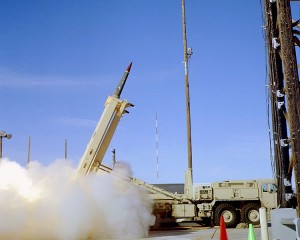Speaking in Washington on April 3, 2013, Defense Secretary Chuck Hagel said the U.S. can’t afford to dismiss North Korean threats as bluster. “It only takes being wrong once, and I don’t want to be the secretary of defense who was wrong once, so we will continue to take these threats seriously,” he said.[i] Secretary Hagel is correct that the U.S. can’t afford to be wrong when it comes to North Korea’s threats of nuclear annihilation; however, one must question whether the handling of this latest episode of brinkmanship would have been better managed quietly. Further, and more importantly, the sudden overt nature of the U.S. response raises additional questions as to what ends the U.S. aims to achieve by stoking fear of an attack. These ends it appears are dangerously similar to the classic war for profit strategies underpinning nearly every war in history.
Investigative journalist Patrick Henningsen gets directly to the point. He states:
One can also argue there are very powerful vested interests in the US corporate structure who have, and will continue to benefit from a heated arms build-up, and will certainly use the North Korea threat as a justification to push forward spending, especially in light of Washington’s new found austerity culture ushered in through recent budget sequestrations.[ii]
Henningsen is not alone calling out the all too ironic correlation in time between sequestration cuts to the Department of Defense and the “sudden” threat from North Korea. Apparently, the public didn’t swallow the war with Iran and so a new boogeyman had to be resurrected “Cold War” style to justify ever-increasing defense budgets that have long since surpassed the ridiculous level. Loren Thompson writing for Forbes.com agrees and provides an articulate and informed article that lays out why the U.S. missile defense program is more than capable of effectively eliminating the missile threat from North Korea. As such, Thompson implicitly argues that any fear of a North Korean missile threat is baseless. Expanding on this, Thompson then goes on to discuss how this missile “threat” will be used to justify budget lines. He states:
The bellicose behavior of North Korea’s leaders in recent days will undoubtedly lead to calls for increased spending by the U.S. government on missile-defense efforts. The public has grown accustomed to living in a world where Chinese and Russian leaders have the capacity to destroy much of America in an hour, because those countries appear to be run by level-headed leaders. North Korea’s mercurial Stalinists are another matter. So missile defense is one mission likely to escape any downturn in military spending, and with good reason.[iii]
Henningsen is no conspiracy theorist and is only rearticulating what the defense lobby has directly come out and said it would do to convince Congress to re-appropriate money cut from defense programs as a result of sequestration. Specifically, Dan Stohr, the spokesman for the Aerospace Industries Association (AIA) stated: “We’re trying to strategize how we want to approach this in a way that really raises the volume in an effective way and convinces Congress that they need to do something about this as soon as possible.”[iv] Based on this, it appears Stohr and the aerospace industries found their strategy, over-hyped threats from N. Korea!
The smoking gun providing the nexus between Stohr’s statements, the “created” false fear of North Korean missiles, and the defense industry is found in the cut defense programs targeting the aerospace industry. Extremely expensive missile defense systems developed by Raytheon Co, Lockheed Martin Corp, and Boeing Co are on the budget chopping block, which threaten to cut billions of dollars from these major defense companies’ bottom lines. Specifically, the new budget would scale back deployment of advanced radars built by Raytheon Co as well as a Lockheed Martin Corp Theater High Altitude Area Defense, “THAAD,” antimissile system, which has been heavily touted in the news recently as being deployed to Guam. Further, President Obama’s defense budget proposal would relegate Raytheon Co’s Sea-based X-Band Radar to “limited test support” status.[v] These giants of the defense industry are not going to take billion dollar cuts lightly and will do whatever necessary to secure this funding, including provoking war. To this end, the defense companies would argue these are critical defense systems needed to deter the “growing North Korean missile threat,” but would not be honest. In reality, these systems are due to be cut because over $100+ billion have already been spent on the more capable Aegis missile defense systems to include the nearly 30 ballistic missile defense (BMD) capable Navy vessels. In fact, many of these vessels are already stationed in the Pacific and providing more than an adequate defense to any missile threat by North Korea. As such, to prevent billions of dollars in defense contracts being cut, Stohr and his fellow captains of the military-industrial complex are risking the lives of millions by artificially creating a crisis on the Korean Peninsula. This resurrected classic Cold War tactic (the use fear to justify massive increases in defense spending) has dangerously raised the stakes with North Korea and must be exposed before the defense contractors again suck America into another unnecessary and bloody war for profit.
By Guiles Hendrik and Ryan Daniels
[i] “Amid Threats, N. Korea’s Neighbors Rethink Defense Policies;” Tom Gjelten; April 03, 2013 3:00 PM; http://www.npr.org/2013/04/03/176166676/north-korea-has-u-s-and-south-korea-rethinking-defense-policies.
[ii] “North Korea: Beyond the Cold War Theatrics, what is the real threat?” Patrick Henningsen; April 06, 2013 14:02; http://rt.com/op-edge/north-korea-us-danger-279/.
[iii] “Can U.S. Defenses Cope With North Korea’s Missiles?” Loren Thompson, 4/05/2013; 12:57PM; http://www.forbes.com/sites/lorenthompson/2013/04/05/can-u-s-defenses-cope-with-north-koreas-missiles/.
[iv] “Defense industry shifts focus to minimizing damage from sequester;” Jeremy Herb; 02/17/13 07:00 AM ET; http://thehill.com/blogs/defcon-hill/policy-and-strategy/283543-defense-industry-shifts-to-shut-off-sequester-not-stop-it.
[v] “REFILE-Obama trims missile defense request;” Jim Wolf; Feb 13, 2012; 6:46pm EST; http://www.reuters.com/article/2012/02/13/usa-budget-missiledefense-idUSL2E8DDEQ020120213.

Pingback: The Military-Industrial Complex Strikes Back: North Korea and War for Profit | Last Minute Survival